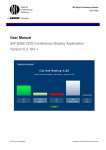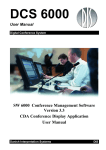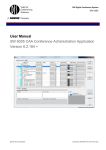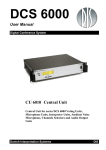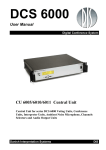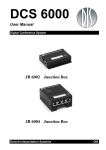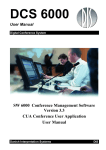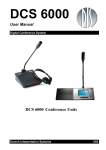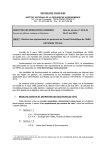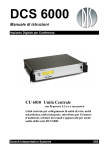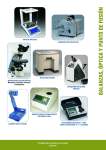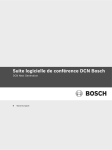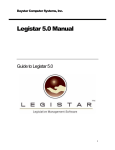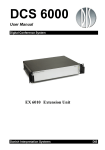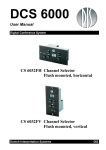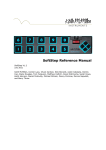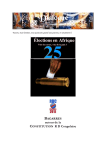Download CAA User Manual ver 3.3
Transcript
DCS 6000
User Manual
Digital Conference System
SW 6000 Conference Management Software
Version 3.3
CAA Conference Administration Application
User Manual
Danish Interpretation Systems
DIS
Danish Interpretation Systems
Copyright © 2006 DIS
User Manual
CAA USER MANUAL VER 3.3.DOC
04-05-2006
No part of this publication may be reproduced or utilised in any form or by any means without permission in writing from the
publisher.
Danish Interpretation Systems
User Manual
List of Contents
Description of the DCS 6000 system ................... 5
Reports..............................................................23
Delegate List Report ......................................23
Features.............................................................. 5
Agenda Report ...............................................25
System components........................................... 5
Central equipment ........................................... 5
Conference Log Report..................................27
List of Contents..................................................... 3
Interpreter equipment ...................................... 5
Setup .................................................................28
Setup/Equipment/Seat....................................28
Conference equipment and channel selectors . 5
Setup/Equipment/Interpreter Units ................31
Operating instructions ......................................... 6
SW 6000 – CAA application............................. 6
General description ......................................... 6
Setup/Equipment/AO Units ...........................33
Setup/Equipment/Ambience Microphone......34
Setup/Equipment/Conference displays ..........35
Features ........................................................... 6
Setup/Equipment/Chip cards .........................36
Starting the CAA............................................... 7
Setup/Configurations/Voting Configuration..38
Login .................................................................. 8
General screen functionality............................ 9
Setup/Configurations/Mimic Configuration ..44
Search List....................................................... 9
Setup/Configuration/Delegate List
Configuration .................................................47
Language Tabs ................................................ 9
Buttons .......................................................... 10
Conference....................................................... 11
Conference Mode .......................................... 13
Setup/Configurations/CDA Configuration ....46
Setup/User Type ............................................48
Setup/Language/Languages ...........................52
Setup/Language/Labels..................................53
Microphone Operation Mode ........................ 14
Setup/Rooms/Create Room............................54
Delegate list................................................... 15
Setup/Rooms/Manage configuration .............55
Agenda .......................................................... 17
Setup/Rooms/Create Connections .................56
Options .......................................................... 18
Setup/Rooms/Connect to Room.....................56
Delegate............................................................ 20
Delegate Information .................................... 20
SW 6000 Backup Utility ..................................57
Backing up data .............................................57
Messages .......................................................... 22
Copyright © 2006 DIS
Restoring data ................................................59
CAA USER MANUAL VER 3.3.DOC
04-05-2006
No part of this publication may be reproduced or utilised in any form or by any means without permission in writing from the
publisher.
Danish Interpretation Systems
4
User Manual
Manual 01 19 60013
Danish Interpretation Systems
User Manual
Description of the DCS 6000 system
Features
Interpreter equipment
The SW 6000 Conference Management Software
for PC opens a completely new way of managing
conferences. It is designed to operate with the
hardware units, which are part of the DCS 6000
system
DCS 6000 system is a complete “State of the Art”
fully digital integrated interpretation, discussion and
voting system offering interpretation, language
distribution, conference microphone and voting
facilities with attendance check with Chip Card ™.
The DCS 6000 system is based on a new, unique
digital DATA and AUDIO bus using standard
network cable. This ensures a very cost effective
installation and easy set-up of portable systems.
A total of 4000 units (delegate or interpreter units)
can be connected to the system.
The DCS 6000 system can be operated with or
without a PC. If external operation of the system is
needed the CU 6010 features a RS232/RS422
connection for PC or control system such as AMX
or Crestron.
IS 6132P
LS 6032P
Conference equipment and channel
selectors
CS 6032FV/H
CM/DM 6010P
CM/DM 6020P
CM/DM 6070P
CM/DM 6090P
CM/DM 6060F
CM/DM 6510F
CM/DM 6560F
System components
The DCS 6000 system consists of various units.
MU 6040C/D
Central equipment
CU 6010
EX 6010
AO 6008
JB 6002
JB 6004
Central Unit with built-in
network controller and power
supply
Extension Power supply
Audio Output box
Junction Box with 2 outputs
Junction Box with 4 outputs
Interpreter Set
Interpreter Loudspeaker
MU 6042D
AM 6040
Manual 01 19 60013
Channel Selector (flush mounted)
Conference Unit (portable)
Conference Unit (portable) with
XLR microphone connector
Conference Unit (portable) with
two built-in channel selectors
Conference Unit (portable) with
two built-in channel selectors and
XLR microphone connector
Conference Unit (flush mounted)
with one built-in channel
selectors
Conference Unit (flush mounted)
with Chip-card and 3 voting
buttons
Conference Unit (flush mounted)
with one built-in channel
selector, Chip-card and 3 voting
buttons
Microphone Unit for use with
customised front plate with
Loudspeaker, Microphone and
Buttons. Available in Delegate
(D) and Chairman (C) version
Dual Microphone Unit for use
with FD/FC front plate with
Loudspeaker, Microphone and
two delegate Buttons
Ambient Noise Microphone
5
Danish Interpretation Systems
User Manual
Operating instructions
SW 6000 – CAA application
•
Full language support
•
Very user friendly Graphical design of high
quality
•
Data stored in SQL database format
General description
The SW 6000 software package consist of several
main applications:
Features
CAA Conference Administrator Application
The main features of the CAA Conference
Administration Application are:
CUA Conference User Application
CDA Conference Display Application
•
ECA External Control Application
The SW 6000 software package has the following
main features:
6
•
Client/server system for multiple PC’s
•
Multiple User profiles with different
functionality
Manual 01 19 60013
Used by the people mainly outside the
conference room who are responsible for
creating and maintaining basic conference
data such as conferences, delegates,
delegate lists, messages etc. and who
monitor the system status during
conferences.
Danish Interpretation Systems
User Manual
Starting the CAA
After the CAA has been
installed, the CAA shortcut is
placed on the Desktop and in the
start folder.
Clicking the CAA shortcut will
start the application
Manual 01 19 60013
7
Danish Interpretation Systems
User Manual
Login
When the application is started
the user must select a language if
more languages are in use.
If only one language is in use,
then the Login screen is not
presented.
A user ID or password is not
required. If restricted access to
the CAA application is needed,
use the standard. Windows logon
when starting up Windows.
After selecting the language the
application will present the
following screen. If the
application is run for the first
time you will see this screen
directly. At the top of the screen
a menu provides access to all the
different CAA screens:
8
Manual 01 19 60013
Danish Interpretation Systems
User Manual
General screen functionality
The following describes the
general functionality that applies
to all screens in the Conference
Administration Application
(CAA).
The above example shows the screen for creating and editing messages.
Search List
The left side of the screen will display a list of messages that allow the user to search for and select a specific
message to edit. The ’Search for...’ field provides free text search on the texts displayed in the list. Entering the
text ’ther’ in the shown example would place focus on the first message where the text is found. In this case
‘There is a phone call …..’ would be found.
A vertical scroll bar will appear to enable scrolling down the message list if additional one’s exist off the screen.
Language Tabs
The right side is for the actual functionality related to the menu selection. A tab for each language will be
available. The user can flip through the language tabs when creating or editing data thereby entering a
translation for the different languages. The system will require the user to enter data for the default language,
which is the language on the first tab from the left (e.g. English).
Entering data for the rest of the languages is optional.
Selected fields will be highlighted in yellow.
Manual 01 19 60013
9
Danish Interpretation Systems
User Manual
Buttons
Throughout this manual buttons will be referred to by putting the button text in brackets like [Add]. The
following buttons are generally implemented on all screens:
[Add]
Press the button to add a new record. That can be a conference, a delegate, a message or similar
record. When the screen is in edit mode then all fields will be sand coloured. When the adding of
information is complete (possibly for several languages) then press the [Update] button to save
the information.
[Delete]
Press the button to delete selected record information. That can be a delegate, a conference or
similar. Information for the record in all languages will be deleted.
[Update]
When the user is adding or editing information the changes are saved by pressing this button.
Editing existing information is done simply by selecting the information and changing it. The
fields will be sand coloured to show that the screen is in edit mode.
[Copy]
Select one setup and press this button. A copy of the setup selected will be created.
[Cancel]
Press the button to avoid saving changes just made or saving a newly added record. If an existing
record was being edited then the old data will reappear.
[Close]
Press the button to close the window. All windows must be closed before exiting the CAA
10
Manual 01 19 60013
Danish Interpretation Systems
User Manual
Conference
Clicking the ‘Conference ’ brings
up the ‘Conference’ page,
This screen is used to create
conferences, delegate lists
assigned to a specific conference
and to specify operation
parameters to be set when the
conference is activated.
Any number of conferences can
be created.
The names of the conferences
will normally be a specific
conference like ‘Sales Meeting’
or ‘Annual Meeting’ running a
limited period of time.
A type of conference like
‘Conference: No login’, where
the ‘Start date’ and ‘Stop date’ is
covering a large period of time or
the names is all very useful as
this is an easy way to set
conference parameters.
Default conference
language
The English language is always default and cannot be unchecked ‘and the English language is
always ‘.
In use
The English language is always default and cannot be unchecked and therefore the English
language is always ‘In use’
However if other languages are used in the conference, which are created, the option ‘Language in
use’ has to be selected. When a conference is started, only the languages selected will be presented
to the user.
ID
An alpha-numerical value use to identify the conference
Conference
Name of the conference.
Conference Mode
The conference mode determines, how delegates are know to the system.
Please refer to the section ‘
Conference Mode.
Manual 01 19 60013
11
Danish Interpretation Systems
Microphone
operation mode
User Manual
Select the microphone mode to be used when the conference is started. Options are ‘Automatic’,
‘Manuel’, ‘FiFo’ and ‘VOX (Voice active)’. VOX option only if the CU 6010 features this mode.
Please refer to the section ‘Microphone Operation Mode’
Voting Parameters
The default voting parameters for the conference can be set using a dropdown box.
A set of voting parameters is created in ‘CAA/Setup/Voting parameters’. The default voting
parameter for the conference can always be changed in the CUA before a voting session is started.
Start and stop dates Those date fields are used to specify when the conference is to be held. Only conferences are visible
in the CUA Application if today’s date falls on or between these two dates.
Those date fields are used to specify when the conference is to be held. Only conferences are visible
in the CUA Application if today’s date falls on or between these two dates.
[Delegate List]
Press this button to call the function for creating a delegate list for the conference.
The button is only enabled if the conference mode is set to ‘Prepared delegate list’, ‘Login using
code and list’ or ‘Login using code on list’.
Please refer to the section ‘Delegate list’
[Agenda]
Clicking this button bring the ‘Agenda’ popup used for creating an Agenda to a conference.
Please refer to the section ‘Agenda’
[Delegated Votes]
Some conference units are supplied with
an extra “voting” button. This button can
be used for casting a vote for another
person. The “Delegate Votes” button
shows a list, where Delegates are
assigned permission for voting for
another delegate.
[Options]
The ‘Option’ button brings the ‘Option’ popup, which is used to set operation settings of the system
used when starting the Conference.
Please refer to the section ‘Options’.
[Stop Conference]
Use this button to stop a conference
[Copy]
The copy function will make a copy of the selected conference. Both ‘Delegate list’, ‘Agenda’,
‘Delegated votes’ and ‘Option’ settings are copied.
12
Manual 01 19 60013
Danish Interpretation Systems
User Manual
Conference Mode
Select one of the five available modes for the conference:
Prepared Delegate
List
Use this mode to create a list of
delegates with names of all the
delegates attending the conference.
Each delegate is assigned a seat with a
microphone. The assignment of seats is
done by clicking the ‘Delegate List’
button. Se later section: ‘Creating a
Delegate List’.
A seat, having a PC running the CUA
Application, will show the name and
other information of the delegate on the
Language Selection Screen and other
screens and on various lists.
Login using code
Selecting this option will allow permanent delegates to login at the CUA Application using their
individual ‘login codes’.
If the functionality “Setup/equipment/chip cards: Units with chip card” is selected, the login code
is taken from a chip card inserted in the conference unit. In this case the user will not be presented
for a login screen when starting the CUA.
Delegates using conference units without chip card reader will be shown on various delegate
screens/lists with the seat number instead of their name.
Login using code and
list
Selecting this option will allow permanent delegates to be assigned a specific seat with a
microphone. The delegates has to login at the CUA Application using their individual login
codes, but the delegate can only login to the seat assigned to him.
If the functionality “Setup/equipment/chip cards: Units with chip card” is selected, the login code
is taken from a chip card inserted in the conference unit. Then the user will not be presented for a
login screen when starting the CUA.
Delegates using conference units without chip card reader will be shown on various delegate
screens/lists with the seat number instead of their name.
Login using code on
list
Selecting this option will allow delegates present on a Delegate List to login at the CUA
Application using their individual login codes at any seat.
If the functionality “Setup/equipment/chip cards: Units with chip card” is selected, the login code
is taken from a chip card inserted in the conference unit. Then the user will not be presented for a
login screen when starting the CUA.
Delegates using conference units without chip card reader will be shown on various delegate
screens/lists with the seat number instead of their name.
No login
This option will not use names of delegates. All delegate lists will show the seat number.
In this mode, the ‘Delegates’ screen will not be available at the CUA application
Manual 01 19 60013
13
Danish Interpretation Systems
User Manual
Microphone Operation Mode
The Microphone operation mode (system mode) can always be changed during a conference using the
Conference page in the CUA.
Individual microphone settings which might be assigned to any conference unit are not overridden. See section
Setup/User Types for further details about Individual microphone settings.
The following operations modes (system modes) can be pre-selected for the conference:
Manual
All delegates speak requests are inserted into the Request list. Their microphones are turned on
when Chairman grants the individual delegate the right to speak. Microphones with Chairman
priority will always be turned on.
Automatic
All delegates speak requests causes their microphone to turn on if the maximum number of
speakers is not reached. Otherwise the speak request will be rejected. Microphones with
Chairman priority will always be turned on.
FIFO
First In First Out. All delegates speak requests causes their microphone to turn on if the maximum
number of speakers is not reached. Otherwise the speak request will be inserted onto the request
list. The first on the request list will be turned on when one of the active microphones is turned
off.
Microphones with Chairman priority will always be turned on directly.
VOX
Speaking into a Delegate microphone will turn on the microphone if the maximum number of
Delegates is not reached. Otherwise the speak request will be rejected.
Speaking into a Chairman microphone will turn on the microphone if the maximum number of
Open Mics. is not reached. Otherwise the speak request will be rejected. Chairman units will
interrupt a Delegate unit if the max. number of Open Mics. are reach
Operation settings for the VOX mode can be set on the CU 6010.
14
Manual 01 19 60013
Danish Interpretation Systems
User Manual
Delegate list
Press the [Delegate list] button
to call the function for creating a
delegate list for the conference.
The button is only enabled if the
conference mode is set to
‘Prepared delegate list’, ‘Login
using code and list’ or ‘Login
using code on list’.
[>>]
Existing delegates from the Delegates database will be shown in the left window. Selecting a
delegate and then clicking ‘>>’ will place the delegate in a seat number 1 in the delegate list. The
seat will automatically be generated, when clicking ‘>>’.
Selecting an empty seat before clicking ‘>>’ will place the delegate in that seat.
Selecting a seat occupied by a delegate, before clicking ‘>>’ will place the delegate in a new seat.
[<<]
Selecting a seat and clicking ‘<<’ will remove a delegate from a seat.
Clicking ‘Clear Seat will also remove a delegate from a seat.
[Add entries]
Press this button to create the number of seats, which will be
used for the conference.
[Delete Entry]
Press this button to delete a selected seat.
[Clear seat]
Press the button to remove data for a selected seat
Manual 01 19 60013
.
15
Danish Interpretation Systems
User Manual
[Move]
Press this button to move a delegate from one seat to another.
[Delete list]
Press this button to delete all seats.
[Import delegates]
Use this button to import a list of names from an XML file.
[Export delegates]
Use this button to export a list of names to an XML file.
[Show Active]
Clicking ‘Show Active’ will show all delegates in the Delegates Database marked as ‘Active’.
[Show All]
. Clicking ‘Show All’ will show all delegates in the Delegates Database.
.
[Hide] Delegate
Database
Clicking the ‘Hide’ button will remove the Delegate window. It is now possible to assign specific
values for the conference, different from the entries made for the delegate in the Delegate
database. The following values can be changed:
[Show] Delegate
16
•
User Type
•
Voting Weight
•
Voting Parameter
•
Microphone Level
Clicking this button will show the ‘Delegate’ database window.
Manual 01 19 60013
Danish Interpretation Systems
User Manual
Database
After adding a seat a delegate can be assigned to a seat by typing the Id number in the ID field.
Inserting delegates
into seats when hiding
the Delegates
database,
Agenda
The agenda is a list of subjects
with a title and description.
Adding subjects build the
Agenda one by one.
New subjects are added
automatically when entering text
on a blank line below the last
subject.
The agenda shows all subjects
including indentation.
An agenda can be created using
the buttons to the right
Note: Rows must not be left
blank for the default
conference language.
[Insert]
This button inserts a blank row above the selected row allowing the user to add a new subject
[Remove]
This button deletes the selected subject unless a vote result exists for the subject
[Move up]
This button moves the selected subject one row up allowing the user to reorder the Agenda
[Move down]
This button moves the selected subject one row down allowing the user to reorder the Agenda
[Import]
Import Agenda from an XML file.
I dialog box will be presented for the option of
deleting an existing agenda or add the import to the
existing agenda
[Delete all]
This button deletes all subjects. You have to confirm your choice
[ >> ]
This button increases indentation one level. A limit of 6 indentation levels must apply.
Manual 01 19 60013
17
Danish Interpretation Systems
User Manual
[ << ]
This button decreases indentation one level
Description
A description to each point in the agenda can be added. This description will be visible in the
‘Agenda’ window in the CUA.
Default language
description
When adding the description of an agenda subject to other languages the description for the
default language can be seen in the ‘Default language description’ window. This will ease the
translation to the other languages.
Options
The ‘Option’ button brings the
‘Option’ popup, which is used to
set operation settings of the
system used when starting the
Conference.
.
Max Delegate Speakers
Set the maximum Delegates allowed. The value can be
set from 1 to 8.
Max Open Mic
Set the maximum open conference units allowed. This
included both Delegate Units and Chairman Units. The
value can be set from 1 to 8.
Max Speak Requests
Set the maximum no of names in “Request to speak”
queue. The value can be set from 0 to 255.
Individual Mic Level
Use Delegate Setting
When ticked, the microphone level will be set in
according to the setting mad at the ‘Delegate List’
Mic Off Mode
Auto Off
When ticked a Conference unit will switch of after the
time set, if nobody is talking in the microphone.
Microphone
Parameters
18
Manual 01 19 60013
Danish Interpretation Systems
Microphone Interrupt None
Ability
Speech Time Limit
User Manual
Cannot interrupt another speaker
Lower
Can interrupt a speaker with a speak priority less than
own speak priority
Same/Lower
Can interrupt a speaker with the same speak priority or a
speak priority which is less than own speak priority.
A maximum speech time for a delegate or a group of delegates can be set
Preset Speech Time
When ticked the speech time is enabled.
Set a value to limit the time each delegate
‘Individual/All’ or a group of delegates ‘Groups/All can
speak.
Voting Parameters
Display Application
Setup
Incrementing
Select this option to make speech time counters display
elapsed time starting from zero and counting up.
Decrementing
Select this option to make speech time counters display
elapsed time starting at the speech time limit and
counting down to zero.
Accumulating
Set this option to add up the speech time every time a
delegate is speaking. If the option is not set then the
speech time limit will reapply every time a delegate is
speaking.
Close mic on timeout
Set this option to have the microphones turned off
automatically by the system when the speech time limit is
reached.
Alarm before timeout
Set the alarm time to make the speech time counters flash
when the alarm time is reached. Setting the time to 00:00
disables the alarm time function.
Preset voting time
When ticked the voting time is enabled. After the time
set, the voting session will stop automatically.
Counting up
Select this option to make voting time counters display
elapsed time starting from zero and counting up.
Counting down
Select this option to make voting time counters display
elapsed time starting at the time limit and counting down
to zero.
It is possible to have up to 8 CDA applications running (on 8 PC).
Various setups can be created in the CAA application. For each conference it is possible to assign
any created setup to any of the CDA applications running.
Manual 01 19 60013
19
Danish Interpretation Systems
User Manual
Delegate
Delegate Information
Permanent delegates who attend
conferences on a regular basis
can be created using this screen.
Delegate id, Name, User Type
and Login Code fields are all
mandatory and has to be filled
in.
User id
A numeric value up to 5 digits, unique for each delegate, which is identifying the User. When a
delegate is added to the list of delegates, the ID cannot be changed. If chip cards are in use, this ID
has to match the ‘Delegate Id’ programmed on the card.
Login code
Enter a unique login code to be used by the delegate for logging in to the CUA Application.
[Generate]
Press the button to generate a random number for the Login Code/User id. When adding new
delegates, unique Login Code/User id will automatically be assigned.
Name
Name of the delegate
User Type
Select one of the existing user types from the drop down list. The user type will determine what
screens, buttons, individual microphone settings and functionality will apply to the delegate’s CUA
Application and microphone operation when the delegate is logged in.
Title
Title or position of the delegate
User Table 1-4
Four user-defined fields are available for entering various text information. Their labels can be set
to describe the content of the fields from the label screen. Their label numbers are 1810 to 1813.
Write any text or select predefined text from the drop down list.
20
Manual 01 19 60013
Danish Interpretation Systems
[User table 1- 4]
User Manual
Pressing the buttons will call popup screens that allow the user to create and maintain predefined
selections for each of these four fields.
The description of the fields can be changed in ‘Setup/Language/Label’.
Group
A delegate can be assigned a group of delegate. This is useful if ‘Group Speech Time’ is used
[Add Groups]
This button will bring a popup for adding delegate Groups.
Background
The user can enter any free text information here to be displayed on the Delegate information screen
in the CUA Application.
Voting Group
This field is used to insert a character to be using in the voting calculations i.e. ‘F’ for French and
‘N’ for Nederland if the two groups have different voting rights
Microphone Level
Use this setting to assign individual microphone level to a delegate. The setting can be from 0 to -6.
Weight (voting
weight)
This field is used to insert a numerical value given the number of votes the user has. Default value
is ‘1’ (one).
Active
A delegate can be marked a ‘Active’ If marked as active, he will be shown in list sorted by ‘Active’
Picture
A picture of the delegate can be inserted using the [Add] button and removed using the [Remove]
buttons.
A picture added will be displayed on the Delegate information screen in the CUA Application.
[Add] (picture)
Press the button to call a standard Windows interface to select picture files (maximum size 30 Kb –
picture format WxH = 115x120).
Pictures are replaced by adding a new one.
[Remove] (picture)
Press the button to remove a picture from the delegate record.
Manual 01 19 60013
21
Danish Interpretation Systems
User Manual
Messages
This screen is used to create prerecorded messages that can be
used by delegates who have
access to the message screen in
the CUA Application.
A maximum of 4000 characters
can be used for each message.
If a message is created in several
language versions then a delegate
logged in using English can read
and send the message in English
and a delegate receiving it logged
in using Danish will read the
Danish version of the received
message etc
22
Manual 01 19 60013
Danish Interpretation Systems
User Manual
Reports
The following reports are available:
Delegate Information Report
Agenda Report
Conference Log Report
The reports can either be viewed on screen or printed.
Delegate List Report
A conference must be selected
from the list on the right of the
screen.
The report can be configured by
selecting fields to view/print and
also if required, sorting order.
The delegate name and seat
number fields will always appear
on the report.
Title
Select to include the field on the report.
User Type
Select to include the field on the report.
User Table 1- 4
Select to include the field on the report. The field can only be selected if the width of the individual
field is set greater than 0 on the ‘Setup/Delegate List Configuration screen’.
Sort order
Select to sort the report either by Delegate Name or by Seat Number
Printer settings
Set the paper size and orientation
[Create report]
Press the button to create the report. The report will be created in the language selected by the user.
An example of the report is shown below.
Manual 01 19 60013
23
Danish Interpretation Systems
User Manual
Created report
When the report is created it is
displayed for viewing. The User
can scroll up or down, search for
text, zoom in on details or print
the report using standard
Windows printing facilities. An
export features is available for
exporting the reports in various
formats.
Column widths in the report are
determined by the settings on the
‘Setup/Delegate List
Configuration’ screen.
24
Manual 01 19 60013
Danish Interpretation Systems
User Manual
Agenda Report
A conference must be selected
from the list on the right of the
screen. The report can be
configured to include voting
results.
Include voteresult
Select to include voting results
Printer settings
Set the paper size and orientation
[Create report]
Press the button to create the report. The report will be created in the language selected by the user.
An example of the report is shown below.
Manual 01 19 60013
25
Danish Interpretation Systems
User Manual
Created report
When the report is created it is
displayed for viewing.
The User can scroll up or down,
search for text, zoom in on
details or print the report using
standard Windows printing
facilities.
An export features is available
for exporting the reports in
various formats.
26
Manual 01 19 60013
Danish Interpretation Systems
User Manual
Conference Log Report
The Conference Log Report is printed similar to the other reports: A conference must be selected from the list
on the right of the screen, and the ‘Create report’ button pressed. The are not option available.
Created report
When the report is created it is
displayed for viewing.
The User can scroll up or down,
search for text, zoom in on
details or print the report using
standard Windows printing
facilities.
An export features is available
for exporting the reports in
various formats.
Manual 01 19 60013
27
Danish Interpretation Systems
User Manual
Setup
Setup/Equipment/Seat
This screen is used to configure
the seat assignment setting up
relations between microphones,
seat numbers and computers
running the CUA Application.
Seats are automatically created
by the CU Interface application
when information about new
units is received from the CU
6010 Central Unit.
The table can be sorted in
accordance to the various
coulombs by clicking the header.
Note: If a seat has been created, it will
not be deleted automatically, if the
unit is not connected to the CU 6010
anymore. Unused ‘Seats’ have to be
deleted manually.
Units in room
Type in the Room # to filter the list to shown only units placed in the room selected.
Room #
If rooms are linked together for combining system in more room, this field is used for identifying
which room, the unit is located in. The room number is selected by use of a drop down box, with a
list of configured rooms. The available rooms are set in Setup/Room/Room Configuration
Seat #
The seat number must be unique and is used to identify the seat on lists, reports and on the mimic
diagram. It can have a maximum of five numeric characters.
Serial #
Each microphone has a unique serial number encoded into the unit from the factory. The number
000.000.000 must be used to create a seat with a computer but no microphone
Seat Type
This field is identifying the use of the seat, where the conference unit has been placed. The entries
are:
The other labels are only used for identifying the unit, but do not give any functionality.
28
DM
The connected unit is a Delegate Unit
CM
The connected unit is a Chairman Unit
DV
The connected unit is a Voting Unit
PC
The seat is attached to a PC
Manual 01 19 60013
Danish Interpretation Systems
Speaker
Stand
User Manual
If a seat has been set to the Seat Type “Speaker stand”, the unit on this seat will be
turned on with the “Speaker Stand” button on the CUA.
Technician If a seat has been marked as a ‘Technician’, a CUA application running on a PC
assigned to this seat will not be logged out, when starting a conference.
Use serial #
If Delegate units connected are sharing a
microphone, this field is used to identify the
units sharing a microphone.
In the above example unit 000.018.064 is using
the microphone from unit 000.018.195
Note: Chairman units as well as portable units
does not support sharing microphone.
User Type
Specifies the default user type that applies to the CUA Application and the microphone units when
no one is logged in at the seat or a conference is not started.
Computer Name
For seats that have a PC running the CUA application, the name of the PC must be entered for the
seat. The CUA will then control the microphone unit assigned to this seat.
If a seat with a PC running the CUA application for a technician, this position does normally not
have a microphone assigned, the ‘Serial No’ can be inserted as ‘000.000.000’.
For a Technician, the fields ‘Seat type’ must be selected as *Technician’.
Mic
This field is used to apply individual microphone level to a seat
LS
This field is used to apply individual speaker level to a seat
Comments
The text ‘Inserted by CU’ with a time stamp is displayed when the seat was created automatically
by the system. The field can be used to store comments of any kind
Mic on
Red colour indicates that the microphone is ON. Green colour indicates, that the microphone is in
request.
The number in the green indication indicates the number in the request queue.
[Save settings in
CU]
Pressing this button will save the current state of the system into the flash memory in the CU 6010
[Mic check]
Will check a selected seat’s microphone by trying to turn on the microphone (for two seconds).
[PC check]
Will check that MSMQ is running on the computer whose name is specified for the selected seat.
[Mic scan]
This button starts a scanning of all microphones, by switching them On and OFF one by one.
Manual 01 19 60013
29
Danish Interpretation Systems
[Replace Unit]
User Manual
This functionality is used for replacing a defective conference unit or switch units between the seat:
1
Identify the seat number for the defective unit and remove it.
2
Connect the new unit to the CU 6010. The new unit will after a short time show up as the last
unit on the list.
3
Select the line in the ‘Seat’ window with the new microphone
4
Click ‘Replace microphone’ and the following dialog window will appear:
5
Type in the seat number for the defective unit
6
Click OK. The new microphone has now replaced the defective one and has got the
functionality and Seat number of the defective microphone.Click OK
Note: If the microphone was assigned a PC running the CUA interface this User has to logout and login
again for getting control of the new microphone.
30
Manual 01 19 60013
Danish Interpretation Systems
User Manual
Setup/Equipment/Interpreter Units
This screen is used to configure
the use of Interpreter Units and
Interpretation Channels.
Entries are automatically inserted
by the CUI Interface application
when information about new
units is received from the CU
6010 Central Unit.
The table can be sorted in
accordance to the various
coulombs by clicking the header
on top.
Note: If an entry has been created, it
will not be deleted automatically, if the
unit is not connected to the CU 6010
anymore.
Unused units have to be deleted
manually.
Units in room
Type in the Room # to filter the list to shown only units placed in the room selected.
Room #
If rooms are linked together for combining system in more room, this field is used for identifying
which room, the unit is located in. The room number is selected by use of a drop down box, with a
list of configured rooms. The available rooms are set in Setup/Room/Room Configuration
Serial #
Each unit has a unique serial number encoded into the unit from the factory.
Booth#
This field is used to enter the booth number, where the interpreter set is placed. Each booth can max.
be assigned 32 interpreter units. The Language Channel assigned to the booth is assigned at the
‘Booth Ch. Assignment’
A-language
This information field is for informing the channel number (and language assigned to this channel)
which is assigned as the A-channel. This is set automatically.
Desk no
Each interpreter booth can use multiple desks. This field is used to identify the desk no.
B-language
This field is used for assigning a language channel to the B-language of the interpreter set.
B-mode
This field is used to set the mode for the B-channel:
All
Al channels at the interpreter set can be set a B-channel
One
One the channel set as ‘B-language’ can be used at the B-language.
None
The B-language is not in use
Manual 01 19 60013
31
Danish Interpretation Systems
User Manual
Comments
The text ‘Inserted by CU’ with a time stamp is displayed when the unit was created automatically by
the system. The field can be used to store comments of any kind.
AB Switch
Set to ‘On’ the interpreter can switch between the A and B-language with the microphone ‘On’
Backlight
Set to ‘On’ switches on the backlight in the LCD display in the interpreter set
Floor Toggle
Set to ‘On’ enable the toggle of the Floor button.
Mic on
Red colour indicates, that the microphone is ON. ´
Interlock modes
Complete
lock
When ticked, no interpreter can switch ‘On’ his microphone to a occupied channel
No Interlock When ticked any interpreter can switch ‘On’ his microphone to a occupied channel.
The interpreter who was occupying the channels will be switched ‘Off’
Interbooth
lock
A can interrupt A
When ticked, an interpreter can switch ‘On’ his microphone
on his A-channel to a channel occupied by an interpreter using
his A-channel.
The interpreter who was occupying the channels will be
switched ‘Off’
A can interrupt B
When ticked, an interpreter can switch ‘On’ his microphone
on his A-channel to a channel occupied by an interpreter using
his B-channel.
The interpreter who was occupying the channels will be
switched ‘Off’
A can interrupt
A+B
When ticked, an interpreter can switch ‘On’ his microphone
on his A-channel to an occupied channel.
The interpreter who was occupying the channels will be
switched ‘Off’
Conference Units
CS Display
Abbreviation When ticked the abbreviation of the language will be shown in the channel selector
display in conference units
Channel
numbers
When ticked the channel number will be shown in the channel selector display in
conference units.
Please not, that Channel Selector Units will always shown channel numbers
[Replace micro..]
Replaces a unit. See procedures in previous section Setup/Equipment/Conference Units.
[Save settings in
CU]
Pressing this button will save the current state of the system into the flash memory in the CU 6010.
Booth Ch.
Assignment
Use this table to set the language to be used in each interpreter booth. Several booth can have the
same language channels
After making a setting of a system, it is advisable to save the settings in the CU. Please also refer to
the CU 6010 User Manual.
Language Channels Channel in
use (0-31)
Language
32
Type in the number of channels to be used. Pressing [Update] will update the
Channel/Language window to show the number of channels in use.
A language can then be assigned to the channels in use
Manual 01 19 60013
Danish Interpretation Systems
User Manual
Setup/Equipment/AO Units
This screen is used to configure
the AO Units connected.
Entries are automatically inserted
by the CU Interface application
when information about new
units is received from the CU
6010 Central Unit.
Note: If an entry has been created, it
will not be deleted automatically, if the
unit is not connected to the CU 6010
anymore.
Unused units have to be deleted
manually.
Units in room
Type in the Room # to filter the list to shown only units placed in the room selected.
Room #
If rooms are linked together for combining system in more room, this field is used for identifying
which room, the unit is located in. The room number is selected by use of a drop down box, with a
list of configured rooms. The available rooms are set in Setup/Room/Room Configuration
Serial Number
Each unit has a unique serial number encoded into the unit from the factory.
Function
Field, which can be used to identify the function of the unit. This description is used to identify the
units in the CUA application.
Comments
The text ‘Inserted by CU’ with a time stamp is displayed when the unit was created automatically
by the system. The field can be used to store comments of any kind.
Channel and
Volume Settings
The Channel and Volume can be set for each of the outputs at the AO unit.
Manual 01 19 60013
33
Danish Interpretation Systems
User Manual
Setup/Equipment/Ambience Microphone
This screen is used to configure
the Ambience Microphones
connected.
Entries are automatically inserted
by the CU Interface application
when information about new
units is received from the CU
6010 Central Unit.
Note: If an entry has been created, it
will not be deleted automatically, if the
unit is not connected to the CU 6010
anymore.
Unused units have to be deleted
manually.
Units in room
Type in the Room # to filter the list to shown only units placed in the room selected.
Room #
If rooms are linked together for combining system in more room, this field is used for identifying
which room, the unit is located in. The room number is selected by use of a drop down box, with a
list of configured rooms. The available rooms are set in Setup/Room/Room Configuration
Serial Number
Each unit has a unique serial number encoded into the unit from the factory.
Comments
The text ‘Inserted by CU’ with a time stamp is displayed when the unit was created automatically
by the system. The field can be used to store comments of any kind.
34
Manual 01 19 60013
Danish Interpretation Systems
User Manual
Setup/Equipment/Conference displays
This screen is used to configure
the Conference Display
Applications (CDA).
Up to eight PC’s with each a
CDA application running, can be
configured.
CDA No
Numeric field. The number 1 to 8 are valid.
Computer Name
The name of the PC running the CDA application must be entered.
Manual 01 19 60013
35
Danish Interpretation Systems
User Manual
Setup/Equipment/Chip cards
Chip Card functionality is a
feature where delegates identify
themselves to the system by use
of a DIS chip-card. The ChipCard contains information like
User ID, Login Code and
Location ID, which the DCS
6000 system uses to identify the
user of the Conference Unit by
getting the personal details from
the ‘delegate’ database in the SW
6000.
When a conference is started
with conference mode: ‘Login
using code’, ‘Login using code
and list’ or Login using code on
list’ units are cheeked for a valid
chip card.
.
When a card is inserted in a conference unit, the software will identify the user by matching the ‘User ID’ in the
‘Delegate’ database with the ‘User ID’ on the card. After this match the ‘Login Code’ will be checked and first
then the cards will be accepted.
The microphone button will then work, however depending on the ‘User type’ of the logged in person, the
person may be allowed to vote.
If the card is not inserted or is invalid, the microphone and voting button are not usable, however the
loudspeaker and channel selector will still work
[Chip Card Setup] If chip cards has to be
used click this button
36
Manual 01 19 60013
Danish Interpretation Systems
User Manual
Using Chip Cards in
Conference Units
Tick this option, if chip cards are to be used in the system
Location Id
This ID is used to make cards usable only in the installation, they are
intended for. Insert a four or five diget number indentyfing your
installation.
If cards are delivered pre-programmed from DIS, the ‘Location id’ is
marked on the package containing the chip cards.
File number
The entry determines where the information is place on the card.
This field has to be set to ‘1’ (one) if the cards in use are delivered from
DIS.
After clicking [Close], you will be prompted to restart all SW 6000 applications.
[Program Selected The list to the left shows
all names in the Delegate
Names]
Database.
Select the Delegate for
which a Chip Card has to
be programmed.
After selecting the
Delegates, click the
button.
Note. Programming is only
possible if the CP 6000
Chip Card reader is
installed.
[Program Chip Card]
Click this button to program chip cards for the selected Delegates. You
will be prompted to insert the cards to be programmed
[Abort Programming]
Click this button to abort the programming.
[Clear List]
Click this button to un-select all selected Delegates
[Delegate Details
If a card is inserted in the chip card reader, the information (User Id, Login Code, Name, Location Id)
will be shown in the fields above the button. Clicking [Delegate Details] will bring a popup showing
all details about the delegate.
[Delete
Information]
Clicking this card will erase the programmed information on the card.
Delegate information in the Delegates Database will not be deleted.
Manual 01 19 60013
37
Danish Interpretation Systems
User Manual
Setup/Configurations/Voting Configuration
This screen is used to configure a
number of voting setups.
Voting parameters must be
specified as different named
setups, which can be applied
when starting a voting session.
The setups can be applied to a
subject on an Agenda or to a
conference as a default setup. ..
Note: A setup cannot be changed or
deleted once it has been used in a
voting session unless all referring
Agendas including vote results are
deleted.
Voting buttons
Voting setups can be created with either 3 og 5 buttons.
A 3 button voting unit cannot vote if a voting session is started with a 5 button voting setup.
A label for each of the buttons to be used in CUA Application like ‘Yes’, ‘No’ and ‘Abstain’ and a colour that is
used on the mimic diagrams when displaying vote results can be specified.
When a voting session is closed the total of the different button presses are counted and stored in five totals,
which can be referred to from the Quorum, Passed and the 9 vote display column formulas.
1 (Total1)
This is the “Yes” button on standard DIS Conference Units. If this is ticked, this button will be
shown on the CUA
2 (Total2)
This is the “Abstain” button on standard DIS Conference Units. If this is ticked, this button will be
shown on the CUA
3 (Total3)
This is the “No” button on standard DIS Conference Units. If this is ticked, this button will be
shown on the CUA
4 (Total4)
This is not supported on standard DIS Conference Units. If this is ticked, this button will be shown
on the CUA
5 (Total5)
This is not supported on standard DIS Conference Units. If this is ticked, this button will be shown
on the CUA
Total present
The colour specified here will be used to indicate the Attendance
38
Manual 01 19 60013
Danish Interpretation Systems
User Manual
Parameters
Secret voting
session
Individual result will not be shown on the mimic displays.
Display interim
result
Results on the CUA voting screen and on the CDA voting displays will be updated during the
voting session as the delegates enter the votes.
Use delegate weight
A weight value for each delegate permanently created in the Delegate table can be specified. The
Delegate’s vote will be multiplied with this value if the parameter is checked. If the login mode is
‘Prepared delegate list’ then the weight value will be taken from the delegate list table instead of the
delegate table.
An example of the purpose could be a share holder meeting where each share holder has as many
votes as he has shares. In this case you must enter the amount of shares in his weight field in the
delegate table before a voting session. When a session using this parameter is performed his vote
will automatically be multiplied with his amount of shares when the result is calculated.
The five totals for the buttons store the result after the multiplication with the weight values.
Use Quorum
formula
The Quorum formula is only used if this parameter is checked. Otherwise the Quorum formula field
must be blank
Attendance check
Attendance check options are:
No attendance
check
No attendance check is performed before a voting
Automatic
calculated
The total present is calculated as the sum of delegates who pressed a voting button during the voting
session.
Manual
An attendance check voting session must be performed before a voting session with this setting can
be started.
The total present is counted as the sum of delegates who pressed the [Present] button during this
session.
Manual (session)
An attendance check voting session must be performed before a voting session with this setting can
be started.
The total present is counted as the sum of delegates who pressed the [Present] button during this
session.
The total present counted in this session is used until a new attendance check is performed
Login total
The total present is calculated as the sum of delegates who is logged in during the voting session.
Delegates who log in during the session is also counted
Attendance button
When voting from a CUA, the Attendance button options are: All buttons, Button 1, Button 2,
Button 3, Button 4 and Button 5
.
Manual 01 19 60013
39
Danish Interpretation Systems
User Manual
Formula fields
Instead of hard-coding a set of predefined rules a number of formula fields can be implemented. Each of the
formula fields allow the user to specify a formula calculation using MS SQL command syntax and various
columns related to the vote session results.
The result of the Quorum and Passed formulas must be 1 (True) to be interpreted as ‘True’. Anything else is
interpreted as ‘False’
The different vote session and result variables from the database tables to use are:
Table
Field
Field type
Description
Result
Vote1
Integer
Value = 1 for individual Delegates who pressed button 1. Can be used to
calculate totals depending on Parameter
Vote2
Integer
Value = 1 for individual Delegates who pressed button 2. Can be used to
calculate totals depending on Parameter
Vote3
Integer
Value = 1 for individual Delegates who pressed button 3. Can be used to
calculate totals depending on Parameter
Vote4
Integer
Value = 1 for individual Delegates who pressed button 4. Can be used to
calculate totals depending on Parameter
Vote5
Integer
Value = 1 for individual Delegates who pressed button 5. Can be used to
calculate totals depending on Parameter
Present
Integer
Value is always 1. Can be used to calculate totals depending on Parameter
Parameter
Character(3)
A way of grouping the permanently created delegates. This could be
political party membership or nationality etc.
Weight
Integer
A value indicating the Delegate’s weight in vote sessions. It could be
number of shares etc.
Total1
Integer
Sum of delegates who pressed button 1. Multiplied with Weight if ‘Weight
in use’ parameter is checked.
Total2
Integer
Sum of delegates who pressed button 2. Multiplied with Weight if Weight
in use parameter is checked.
Total3
Integer
Sum of delegates who pressed button 3. Multiplied with Weight if Weight
in use parameter is checked.
Total4
Integer
Sum of delegates who pressed button 4. Multiplied with Weight if Weight
in use parameter is checked.
Total5
Integer
Sum of delegates who pressed button 5. Multiplied with Weight if Weight
in use parameter is checked.
TotalPresent
Integer
Total of delegates who had ability to vote during this vote session.
TotalSeats
Integer
Sum of seats with hardware/software voting capability
VotingSession
The syntax for the formula fields is the same as available in a SQL select list. Each formula is treated as a field
in a SQL Select list.
Writing a correct formula requires knowledge of Microsoft SQL server syntax. Especially the CASE function
construction must be understood including operators such as AND, OR etc.
40
Manual 01 19 60013
Danish Interpretation Systems
User Manual
There are fine help descriptions in the Microsoft documentation, which can be obtained from Microsoft or DIS.
Here are some examples of formula expressions of various complexities that will calculate if a voting is passed
or not. The button definitions are:
Button 1 is Yes
Button 2 is Abstain
Button 3 is No
Example 1
We have exactly 120 appointed Members and more sum(Vote1) > 60
than half of them must vote Yes regardless of how
many of them are present during the voting:
Example 2
Exactly half or more of the present delegates must vote sum(Vote1) >= (sum(Present) / 2)
Yes:
The Parameter value is taken from the delegate list table if the login mode is ‘Prepared delegate list’. In all other
cases it is taken from the delegate table.
Quorum formula
The user can define a formula in this field that will determine if a voting session is legal or not. A Quorum is
normally based on a calculation of present delegates being equal to or more than a required number.
The Quorum formula is calculated after stopping the vote session but before displaying the result. If the result of
the Quorum formula is 1 it is interpreted as ‘Quorum obtained’. Anything else is interpreted as ‘Quorum not
obtained’.
Here are two different examples that show two ways of calculating:
Example 3
At least 2/3 of the number of appointed members (120) sum(Present) >= 120*(2/3)
must be present.
or
80 and above is OK
TotalPresent >= 120*(2/3)
Example 4
More that 2/3 of the number of appointed members sum(Present) > 120*(2/3)
(120) must be present.
or
81 and above is ok but 80 and below is not ok
TotalPresent >= 120*(2/3)
Passed formula
A vote session can result in either ‘Passed’ or ‘Not passed’. If the Quorum formula is used and the result is
“true” being ‘Quorum obtained’ the result is calculated based on the formula specified in the Passed field.
If the result of the formula is ‘true’ the result is ‘Passed’
If the result of the formula is anything else than ‘true’ the result is ‘Not passed
If Quorum was not obtained the result is always ‘Not passed’ regardless of the result of this calculation.
Manual 01 19 60013
41
Danish Interpretation Systems
User Manual
The result of the Passed formula is displayed on the various vote result screens right after finishing the vote
session. ‘Passed’ is in clear green colour and ‘Not passed’ in clear red colour.
Example 5
Quorum is obtained if the given votes are more than 60. Total1+Total2+Total3>60
Example 6
Quorum is obtained if the given votes are more than the Total1>Sum(Present)*(2/3)
‘Yes’ votes are more than 2/3 of the ‘Present’.
Or
Total1>TotalPresent*(2/3)
Use of Voting Group parameter
Use of delegate ‘Voting Group’ parameter is a way of counting votes from group of delegates separately and use
this count in calculating Quorum or Passed/Not passed resulst.
In the following the ‘Voting Group’ parameter ABC has been used for some delegates and DEF for others.
Example 7
To get all delegates with ‘Voting Group’ = 'ABC' who SUM('ABC')
has casted a vote.
Enclose the ‘Voting Group’ in quotes and use the
SUM-function (you are infact creating a sum of the
individual results...)
Example 8
To get all delegates with ‘Voting Group’ = 'ABC' who SUM('ABC', VOTE1)
has pressed button 1 use the expression
Example 9
So if the statement that "passed" is true if yes-votes for SUM('ABC',VOTE1) > SUM('DEF',VOTE3)
ABC-delegates are greater than no-votes for DEFdelegates.
42
Manual 01 19 60013
Danish Interpretation Systems
User Manual
Vote display column formula
The result of the voting sessions is displayed on several CUA screens or CDA screens in two different ways.
Either as plain numbers due to the limited space on the screen or as column charts with numbers.
Up to nine different results column formulas with labels can be used. For each of the column formulas the user
must specify a header label, colour and a width. The widths are used on the CUA Agenda screen exactly as
shown in the List preview text box.
The same syntax as for Quorum and Passed formulas is applied.
Yes
Total1 is the sum of all who pressed button 1 being defined as ‘Yes’
Abstain
Total2 is the sum of all who pressed button 2 being defined as ‘Abstain’
No
Total3 is the sum of all who pressed button 3 being defined as ‘No’
Not voted
To calculate the sum of those who did not vote at all, use the TotalPresent sum minus the sums of
those who voted Yes, No and Abstain
Present
To display the count of present Delegates write TotalPresent
Seats
To display the count of available seats in the hall the user must write TotalSeats
<blank>
The column formula is not used and must not be displayed
Special buttons
[Edit]
The button [Edit] is showing a window for creating the SQL statement.
The user can cut and paste from the textbox displaying it. An advanced user may want to copy the
statement to the Microsoft Enterprise Manager’s SQL analyzer to try out different syntax
possibilities or to debug the formulas.
[Preview]
This button present a screen preview of the selected parameters
Manual 01 19 60013
43
Danish Interpretation Systems
User Manual
Setup/Configurations/Mimic Configuration
The Mimic Diagram is a
graphical overview of the
conference room or hall.
Each seat has a coloured dot
showing microphone and login
status.
It is possible to make several
mimic diagrams that can be
selected for specific conferences.
Name
Name of the mimic diagram that will be shown on the drop down list on the Conference screen.
Default mimic
One of the mimic diagrams must be marked as default to be used by the system when no conference
is started.
[Add image]
Press the button to select a bitmap through a standard Windows file selection window.
The bitmaps can be created using various standard tools like Microsoft Paint. The bitmap size must
be less than or equal to the resolution of the screen of the CUA applications running the Mimic
diagrams. The standard resolution for the CUA, if the CUA application shall fill out the whole
screen is 1024x768.
[Edit image]
44
Press the button to call a window allowing the user to edit the mimic diagram as described in the
section below.
Manual 01 19 60013
Danish Interpretation Systems
User Manual
Edit image
The screen presents a full screen
view of the imported bitmap
allowing the user to add and edit
seats, and to add buttons for
special functionality.
Right clicking on the image calls
a popup menu presenting the
different options.
The dots and buttons inserted by
use of the popup menu can be
arranged by a standard Windows
drag and drop function.
Seat numbers are displayed when
the mouse is positioned over a
dot.
Remove selected
item
Right click on a button or a dot and select this option to remove it from the mimic diagram
Import all
unassigned seats
Will create a dot on the screen for each entry in the seat table that has not been put on the mimic
yet.
Insert one seat
Displays a list of all seats not already on the mimic allowing the user to select a single seat. The dot
is created where the mouse is pointing.
Remove all seats
Will delete all dots on the screen.
Return, Next Mic
On etc.
Will insert the buttons [Next mic on], [Delegates off], [All req off], [Exclusive], [STP], [Menu],
[Ambient], [CU Line In].
[Menu]
The button [Menu] switches the functionality of the mimic diagram (in the CUA) between
presenting a menu or switching On/Off the microphone directly when touching the dot representing
of a microphone
Return
Will return to the previous screen presenting the user with a popup ‘Save changes yes/no?’. If ‘No’
is selected all the changes are lost.
Not removable button
[Return]
The button [Return] closes the mimic diagram (in the CUA) and returns to previous screen
Manual 01 19 60013
45
Danish Interpretation Systems
User Manual
Setup/Configurations/CDA Configuration
This screen is used to make
setups for the use of the CDA
application.
Multiple setups can be created
given the possibility to assign up
to eight PC’s with the CDA
application running different
screen.
For detailed explanation please
refer to the manual ‘CDA User
Manual’
46
Manual 01 19 60013
Danish Interpretation Systems
User Manual
Setup/Configuration/Delegate List Configuration
This screen allows the user to set
the column widths for the
different lists in the CUA
Application, which show
Delegates.
The total width is a fixed width
determined by the maximum
available space on the CUA
Application screens. The
individual columns can be
omitted from the lists by entering
zero in the width field. Only the
Name and Seat number columns
are mandatory and they have
minimum width requirements.
The ‘Difference’ field shows the
difference between the fixed total
width and the sum of widths
entered by the user.
The Delegate List Preview
window shows exactly how the
lists will appear on the CUA
Application screens. It is possible
to enter test data in the list
preview to fine-tune the width of
the individual columns
Manual 01 19 60013
47
Danish Interpretation Systems
User Manual
Setup/User Type
This screen is used to create and
maintain the various ‘User
Types’ that can be assigned to
delegates and seats.
It is used to specify the screens,
buttons or special functionalities
that apply to a delegate or a
seat’s profile.
A number of standard user types
are created automatically during
installation.
They can be modified or deleted
except the Chairman and
Delegate. The Chairman and
Delegate user type can only be
modified but not deleted.
Screens
The options specify which screens will available to the user of the CUA Application:
Delegate
Shows names, titles, pictures and other information for delegates attending the conference.
Microphones
Microphone management, speakers list, speak request list and last five speakers. Allows the user to
open and close microphones.
Mimic Diagram
Graphical overview of the room or hall showing login and microphone status and allowing the user
to turn microphones on and off, log delegates out and set individual volume level of microphones.
Agenda
Shows the agenda for the current conference.
Result
Shows the voting result.
Messages
Allows delegates to exchange written or pre-recorded messages between each other.
Conference control
Starting and stopping a conference and setting conference parameters
48
Manual 01 19 60013
Danish Interpretation Systems
User Manual
Configuration menu
The ‘Configuration menu’ is a sub-menu in the CUA giving access to screens for setting conference parameters,
adjusting CU 6010 volume controls and adjusting individual microphone unit volume controls
Interpretation
Allow the user to control and monitor the status of the interpreter units.
Display Control
This page is use to select the screen to be shown on the CDA displays
System messages
Displays important system messages generated by the DCS6000 system
Volume control
Adjusting the CU 6010 volume controls and adjusting individual microphone unit volume controls.
Microphone levels
Adjusting individual microphone unit volume controls.
AO units
Control the channel setting and output volume of connected AO units.
Panel Buttons
These options specify which panel buttons will be available to the user of the CUA Application:
Speak
Button for requesting to speak with the same functionality as the button on the microphone unit.
Exclusive Speak
Button for requesting the exclusive right to speak. Will turn off all delegate microphones.
This button will only work, if the user has ‘Speak Priority’ = Chairman
Speaker Stand
Button for turning on or off the Speaker Stand microphone(s).
CU line input
Button for switching On/Off the Line input at the CU
Speaking too fast
Indication button. Turns red, if an interpreter presses his STF button.
Start voting
Button for starting a Voting session
Mute
Button for temporary muting an open microphone
Functionality
These parameters specify special functionality that applies to seats or delegates of this user type:
Microphone
Control
With this option the user has control of microphones in the CUA Microphone screen and Interpreter
Screen.
Technician
Controlled Request
With this option only a user with Technician ‘Unit Type’ can set a microphone in request.
Speaker Time
Control
With this option the user has the right to set speaking time in a CUA
Manual Vote Result With this option the user has the right to type in a voting result using a dialog box.
Room/Hall
Selection
A user with this functionality can switch his application between two or more systems
User Rights
These parameters specify special functionality that applies to seats or delegates of this user type:
Right to vote
With this option the user has the right to vote.
Manual 01 19 60013
49
Danish Interpretation Systems
User Manual
Right to vote when
stopped
With this option the user has the right to vote after the voting session is stopped.
Voting on CUA
A user with this right can vote pro the CUA display.
When this option is set, then voting buttons on a connected conference unit will be disabled.
Right to set subject
With this option the user has the right to set a subject current.
Microphone Parameters
This setting is used to assign individual ‘Modes’ to Users or Seats. For most applications, the ‘Operation Mode’
is set to ‘Use CU mode’. It means that the operation mode for the users is following setting made on the CU, i.e.
if the system is running in Manual mode, the Delegates will run in Manual mode.
The Standard CU modes are found in the following table:
Standard System setting
Operation mode
Speak priority
Interrupt ability
Chairman
Use Cu mode
5
Use Cu mode
Delegate
Use Cu mode
1
Use Cu mode
VIP
Automatic
2
Use Cu mode <
However for certain application, it is desirable to assign individual operations mode, where the user will always
run in the selected mode independently of the ‘System Setting’.
Individual modes
Use CU mode, Manual, Automatic, VOX or FIFO.
Operation Mode
See explanation of the modes in the Conference section
Speak Priority
Use CU mode, 5 (Chairman), 4, 3, 2 (VIP), 1(Delegate) or No Speaking
Rights
Chairman (5) is the highest priority and the microphone will always be
turned on regardless of operation mode.
In the Request list in the CUA, a user with higher speak priority will be
placed before a user with lower speak priority.
50
Manual 01 19 60013
Danish Interpretation Systems
Interrupt Ability
User Manual
Determines the microphone’s ability to interrupt another speaker if the
maximum number of speakers is reached.
Use CU mode
The interrupt ability will follow the setting made in the CU.
<=
Can interrupt a speaker with the same speak priority or a speak priority which is
less than own speak priority.
<
Can interrupt a speaker with a speak priority less than own speak priority
Not allowed
Cannot interrupt another speaker
Manual 01 19 60013
51
Danish Interpretation Systems
User Manual
Setup/Language/Languages
The CUA Application and the
Conference Administration
Application (CAA) offer full
support for multiple languages.
N.B. Languages can only be deleted if
they have not been used.
Default language
The English language, which is created during installation, is the default language.
Name
Name of the language (this will be displayed on the language selection buttons on the CUA
Application and on the language tabs of the different screens in this application).
Culture name
Selects the standard Windows culture that applies to the language. These languages must also be
installed manually on Windows on all PC’s that will use the language.
[Select Font]
Use this button to change of the font and font size in the CAA for this language (Arial is currently
the default for the SW 6000 applications).
Font
Field for showing the selected font
Bold
All text and labels will be in Arial Bold if this option is selected
Font size
Field for showing the selected font size. (Font size 10 is the default size for labels and data fields).
.
52
Manual 01 19 60013
Danish Interpretation Systems
User Manual
Setup/Language/Labels
This screen allows the user to
enter a complete translation of all
labels and system text used in the
CUA Conference User
Application and in the CAA
Conference Administration
Application.
A drop down box ‘Label group’
allows the user to select the
labels grouped by application and
screen.
The system has a complete
factory set of label text in
English that the user cannot
change.
The English language that is
created during installation is
regarded as any other translation
and can be changed by the user.
If a language is created and the
labels is not translated there will
be a * next to all labels in that
language.
Special buttons
[Export languages]
Use this button to export a set of label for one language. Only one language at a time can be
exported. The exported language file cannot be edited.
[Import languages]
Use this button to import a set of label for one language. Only one language at a time can be
imported. Before importing select the language, where you want to import the labels.
Please refer to the following user manual, which by screen dumps are showing numbers for each label and text
for all screens in the CUA Conference User Application and in the CAA Conference Administration
Application:
SW 6000 Conference Management Software
Screen dumps with label numbers
.
Manual 01 19 60013
53
Danish Interpretation Systems
User Manual
Setup/Rooms/Create Room
This screen is used listing the
rooms, which can be connected
together.
Setups for the rooms are created
in ‘/Setup/Room/Manage
Configurations’.
Room no.
An integer value, numbering the rooms
Name
Description of the room
Master
Indicating that this room is the default room, where the CU is located.
54
Manual 01 19 60013
Danish Interpretation Systems
User Manual
Setup/Rooms/Manage configuration
This screen is used to create
setups for the unit in each room
listed in ‘CAA/Setup/Room
Setup’. Multiple setups can be
made for each room.
If multiple setups are to be used
for one room only, then create
one room in ‘CAA/Setup/Room
Setup’ and create the needed
setups in ‘Room Configuration’.
Left window is showing the list
of rooms.
For each of the rooms in the left
panel, a list of created setups is
shown in the right panel. One of
those Setups can then be selected
for the room.
This is done for each room.
[Add] [Delete]
[Cancel]
The buttons are used when creating the setups.
[Seat]
When a new setup is created, this button is used to show the Seat table for the units in this room.
The functionality of the Seats can then be changed as described in CAA/Setup/Equipment/Seat.
[Activating selected
setup]
When each room has been assigned the Setup to be used, this button activates the setup.
Manual 01 19 60013
55
Danish Interpretation Systems
User Manual
Setup/Rooms/Create Connections
This screen is used to create
Connections to other databases
definitions for the CAA and
CUA applications.
Setup/Rooms/Connect to Room
This screen is used to switch
between the database connection
made in the ‘Create Connections’
screen.
56
Manual 01 19 60013
Danish Interpretation Systems
User Manual
SW 6000 Backup Utility
This application is used to backup and restore the SW 6000 database. You need to have ‘Local Administrator
Rights’ to perform a Backup and Restore procedure.
Backing up data
The procedure for backing up data is a follows:
1
Close the CUI, and all CUA and CAA
application
2
Start the application by clicking the shortcut
3
The utility will start.
Clicking ‘Tools/Backup”
4
Fill in the fields:
Server name: This is the name of the PC,
where the database is installed
Database name: This is the name of the
database. Normally this will be ‘SW6000-1’
Click ‘Use Windows Authentication’
Fill in the Backup file path and name
Manual 01 19 60013
57
Danish Interpretation Systems
User Manual
5
Click ‘Yes’ for start backing up the database.
6
The data will be backed up and when finished
the message box ‘Backup Database is
complete’
Click ‘OK’ and click ‘Close’
7
58
Click ‘Exit’ for closing the utility
Manual 01 19 60013
Danish Interpretation Systems
User Manual
Restoring data
The procedure for restoring data is a follows:
1
Start the application by clicking the shortcut
2
The utility will start.
Clicking ‘Tools/Restore”
3
Fill in the fields:
Server name: This is the name of the PC,
where the database is installed
Database name: This is the name of the
database. Normally this will be ‘SW6000-1’,
but it has to be the same as when the data was
backed up.
Click ‘Use Windows Authentication’
Fill in the Backup file path and name as used
when Backing up the data.
4
Click ‘Yes’ for start restoring the database.
Manual 01 19 60013
59
Danish Interpretation Systems
5
User Manual
The data will be restored and when finished the
message box ‘Restore Database is complete’
Click ‘OK’ and click ‘Close’
6
60
Click ‘Exit’ for closing the utility
Manual 01 19 60013





























































